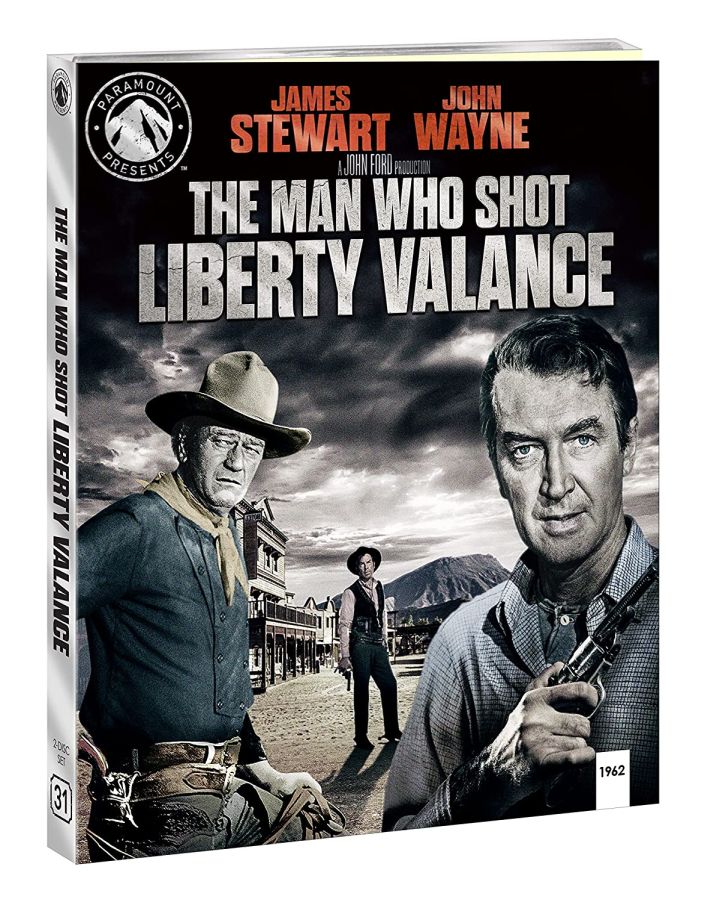
The ubiquity of the popularity of the Western is a cultural phenomenon that is hard to fathom. It wasn’t just a popular genre. It was, for some time, THE popular genre. Western TV shows studded the air waves, Western movies were at the cinema every week. There were Western theme parks, Western vacations, Western restaurants. The closest current cultural touchstone might be the rise and dominance of the superhero film of the last two decades.
And like that genre seems to be doing now, the Western waned. It didn’t touch the culture the way it once did. While it never completely went away, the 1960s saw the end of the classic Western. Then the rise of the revisionist Western (in both the form of foreign productions like Spaghetti Westerns and Hollywood fare like Butch Cassidy and the Sundance Kid or Pat Garrett and Billy the Kid.) These films questioned the underpinnings of heroism that were typical of Western entertainment.
The Man Who Shot Liberty Valence, a late Western that looks like an early Western, was a precursor to this revisionist strain from one of the great directors of those same films being “revised”. John Ford made some of the first truly great Westerns, like Stagecoach and My Darling Clementine. In Liberty Valence, one of his final films, he explores numerous contrasts underpinning Western mythology: Freedom vs civilization; the strength of law and order and the force that has to underpin that strength.
The Man Who Shot Liberty Valence tells the story of a lawyer, Ransom Stoddard (James Stewart) who comes from the East to the uncivilized West. He brings nothing but his dad’s watch, $14.80, and a parcel of law books. His stagecoach is held up right outside of town, and he is robbed and beaten.
He’s eventually found by Tom Donovan (John Wayne) and brought to the local eatery where Donovan’s girl, Hallie (Vera Miles) nurses him back to health. The love triangle is obvious, but the more important conflict is between philosophies. Ransom believes in the rule of law, in voting and conversating. Tom Donovan believes in the rule of the gun. He and everyone else knows the holdup man who beat Ransom was Liberty Valance (Lee Marvin). But the hapless town marshal doesn’t have the wherewithal nor the manpower to bring him to justice. Ransom believes in the power of law but doesn’t know how it can be applied in a world where the Liberty Valances have all the strength of force.
The Man Who Shot Liberty Valence is a movie of strange contrasts. It tells a sophisticated story about the differing currents of civilization in the American West. But the characters, and their actors, are pretty broad stereotypes. This is the movie where the John Wayne cliché of calling city slickers “Pilgrim” comes from. The marshal, the local drunks and cowpokes, Jimmy Stewart and John Wayne have all been playing characters like these for more than 20 years. The interesting and nuanced story doesn’t always rest easy on the rarely-more than two-dimensional characterizations.
What the movie excels in is its pacing, its entertainment value, and its scenework. Shot in black and white and with a clear reduced budget compared to earlier Ford Westerns, The Man Who Shot Liberty Valence has a certain staginess to it. Scenes are typically long and focused into a few locations. Though made in ’62, the film looks more like an early ’40s film than the expansive Westerns filmed in Monument Valley Ford was making in the ’50s. This new 4K release shows off the black and white photography to stunning effect. To my eyes it has nearly perfect clarity. It has to be the best this film has ever looked in a home video release.
But stagey or not, the film balances humor, tension, and drama deftly and without a heavy hand. Liberty Valance is the film’s villain, but the main tension in the film is between Donovan and Stoddard. Liberty Valance (ironic name) is the negative side of freedom – he’s free to rob and terrorize. Tom Donovan is his positive counterpart. He’s as strong and has as much access to violence as Liberty, but he doesn’t use it to terrorize. Ransom Stoddard stands opposed to both sides of the coin of that kind of freedom.
Unfortunately, the last 20 minutes of the film (all of which takes place after someone actually shoots Liberty Valence) basically explicitly explains all these thematic undercurrents. And does a terrible John Carradine performance. Which, if one knows the nadirs of John Carradine, is saying an awful lot. There’s a great plot twist at the end of the film. It could have been handled efficiently and with devastating emotional effect. Instead, it’s a bit tedious, and obvious.
My complaint largely echoes contemporaneous reviews. What lasts of this film, though, is the sense of elemental conflict between the three towering figures of Lee Marvin, John Wayne, and Jimmy Stewart. They’re three different visions of the burgeoning country of America. The film smartly allows enough ambiguity to wonder if the right vision actually won.
The Man Who Shot Liberty Valence has been released on 4K UHD and Blu-ray by Paramount Presents, a home video division of Paramount. The release include a 4K UHD disc with the film, and a Blu-ray disc with the film and extras. There is also a digital code with the film. Extras include an audio commentary with Peter Bogdanovich including archival recordings of director John Ford and actor Jimmy Stewart. There’s a selected scene commentary with Dan Ford and archival recordings by John Ford and Lee Marvin. Video extras include “Filmmaker Focus: Leonard Maltin on The Man Who Shot Liberty Valence” (8 min), and the rather unfocused “The Size of Legends, the soul of myth” (43 min) which in several chapters explores aspects of the film.